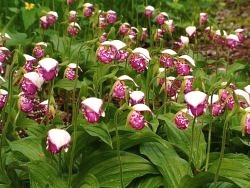 In
our northern Minnesota beds, Cyp. guttatum does very well in a very
sandy substrate with an over-layer of composted bark or leaves or some
other light humus.
In
our northern Minnesota beds, Cyp. guttatum does very well in a very
sandy substrate with an over-layer of composted bark or leaves or some
other light humus.
 Cyp.
guttatum is one of our most beautiful slipper species. In suitable
climate and soil conditions, the creeping rhizomes of the plant spread
almost as a ground cover. The bad news is that this Alaskan plant
does poorly or fails altogether in climates with hot summers and/or mild
winters. We recommend this species only for the northern tier of
the lower 48 U.S. states, northern Vermont, or at high elevation in mountainous
regions.
Cyp.
guttatum is one of our most beautiful slipper species. In suitable
climate and soil conditions, the creeping rhizomes of the plant spread
almost as a ground cover. The bad news is that this Alaskan plant
does poorly or fails altogether in climates with hot summers and/or mild
winters. We recommend this species only for the northern tier of
the lower 48 U.S. states, northern Vermont, or at high elevation in mountainous
regions.
 In
our northern Minnesota beds, Cyp. guttatum does very well in a very
sandy substrate with an over-layer of composted bark or leaves or some
other light humus.
In
our northern Minnesota beds, Cyp. guttatum does very well in a very
sandy substrate with an over-layer of composted bark or leaves or some
other light humus.
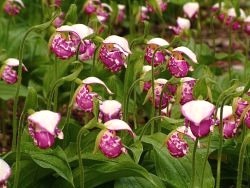 Cyp.
guttatum is one of the most colorful Cyp species. Under good
conditions it reaches a height of over 20 cm (8 inches).
Cyp.
guttatum is one of the most colorful Cyp species. Under good
conditions it reaches a height of over 20 cm (8 inches).
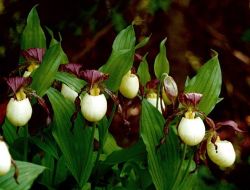 Cyp.
kentuckiense has the largest flowers in the whole genus. This
species is one of the most adaptable to varied climates. Although
its natural range is from the state of Kentucky south to Louisiana, it
manages to survive winters here in northern Minnesota and even grow from
year to year, although it makes faster progress in climates with a longer
growing season.
Cyp.
kentuckiense has the largest flowers in the whole genus. This
species is one of the most adaptable to varied climates. Although
its natural range is from the state of Kentucky south to Louisiana, it
manages to survive winters here in northern Minnesota and even grow from
year to year, although it makes faster progress in climates with a longer
growing season.
 These
are two Cyp. kentuckiense seedlings flowering for the first time.
Note the unusually exquisite coloration of the plant on the left.
These
are two Cyp. kentuckiense seedlings flowering for the first time.
Note the unusually exquisite coloration of the plant on the left.
 Here
is a close-up view of the left-hand plant in the previous photo.
In the future, this plant should be great breeding stock.
Here
is a close-up view of the left-hand plant in the previous photo.
In the future, this plant should be great breeding stock.
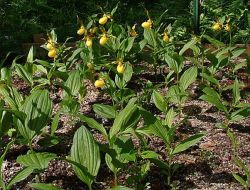 Here
is a bed of Cyp. parviflorum var. pubescens. The whole
bed contains seedlings beginning their third year out of the flask.
Some of the plants shown here also bloomed last year. We wish we
could say that this is typical of third year seedlings, but overall, only
about 10% of the seedlings in this bed bloomed, and they were all located
at one end of the bed. All the seedlings in the bed were planted
in the same medium, so it is a mystery why the plants at one end of the
bed have grown faster than the others.
Here
is a bed of Cyp. parviflorum var. pubescens. The whole
bed contains seedlings beginning their third year out of the flask.
Some of the plants shown here also bloomed last year. We wish we
could say that this is typical of third year seedlings, but overall, only
about 10% of the seedlings in this bed bloomed, and they were all located
at one end of the bed. All the seedlings in the bed were planted
in the same medium, so it is a mystery why the plants at one end of the
bed have grown faster than the others.
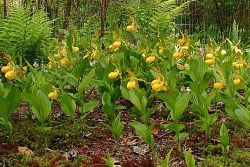 This
photo shows the same Cyp. parviflorum var. pubescens bed
as in the previous photo but one year later, i.e., the seedlings are beginning
their fourth year out of the flask.
This
photo shows the same Cyp. parviflorum var. pubescens bed
as in the previous photo but one year later, i.e., the seedlings are beginning
their fourth year out of the flask.
 Growing
Cyp.
reginae in northern Minnesota is not difficult. Here we have
a bed with seedlings of varying ages. The largest plant on the left
is 12 years old, while there are young plants at the right that have not
yet bloomed.
Growing
Cyp.
reginae in northern Minnesota is not difficult. Here we have
a bed with seedlings of varying ages. The largest plant on the left
is 12 years old, while there are young plants at the right that have not
yet bloomed.
 The
Cyp.
reginae garden plant shown here was photographed at 10 years out of
the flask. When the photo was taken, the plant had 26 flowers.
It has even more now although growth is slowing down. Such large
clumps can be divided to yield many more plants.
The
Cyp.
reginae garden plant shown here was photographed at 10 years out of
the flask. When the photo was taken, the plant had 26 flowers.
It has even more now although growth is slowing down. Such large
clumps can be divided to yield many more plants.
 The
color of Cyp. reginae flowers varies considerably. Plants
growing in full sun frequently have pale flowers, whereas plants in shady
locations often have deep pink on the lip.
The
color of Cyp. reginae flowers varies considerably. Plants
growing in full sun frequently have pale flowers, whereas plants in shady
locations often have deep pink on the lip.
 Cyp.
reginae forma albolabium is a very rare plant. We now
have several such flowering seedlings, some with multiple flowers.
Cyp.
reginae forma albolabium is a very rare plant. We now
have several such flowering seedlings, some with multiple flowers.
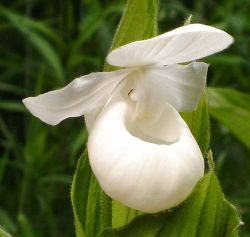 This
is a close-up of the albolabium seedling in the previous photo.
This
is a close-up of the albolabium seedling in the previous photo.
 Cyp.
reginae forma albolabium in the foreground contrasts with normally
colored Cyp. reginae behind.
Cyp.
reginae forma albolabium in the foreground contrasts with normally
colored Cyp. reginae behind.
The Planting Mix
The most important consideration in planting Cypripedium seedlings is to provide a well-aerated environment for the roots. The planting mix should have an abundance of air spaces, and these spaces should never be allowed to fill completely with water. In nature, the requirement for a well-aerated substrate is met in a variety of ways: in light fluffy humus, in soil that is largely sand, in gravel, and in living sphagnum moss where the roots enjoy the large air spaces among the moss fibers. Magnificent Cyp. pubescens plants have even been found growing in squirrel middens consisting of old pine cone fragments. In planting Cyp seedlings, think fluffy.
Provision of such a well-aerated medium in cultivation can be tricky. Simply putting soil, even rich woods soil, in a pot results in a highly compact medium that suffocates Cyp roots. The solution is to dilute the soil greatly with perlite or some other highly porous material. We have found that perlite is the cheapest and most widely available such material. A planting mix of two or three parts perlite to one part of light humus, hardwood forest duff, or leaf mold works very well for potting most North American Cypripedium species. Be very sure not to use clay or a clay-rich soil in the mix.
Some commercial soil-less potting mixes work well for
potting Cyp seedlings. For a couple years we were using Scott's  Metro-Mix
366-P very successfully for potting without adding any additional perlite.
This is a light, fluffy mix consisting of 30-40% coconut coir pith, 20-30%
horticultural vermiculite, 20-30% composted pine bark, and 10-20% perlite.
This product does not contain peat moss which tends to hold too much water
and to become soggy. Metro-Mix 366-P has become increasingly difficult
to find and may no longer be manufactured. Metro-Mix 560, another
product based largely on coir and composted pine bark, may be a suitable
substitute for 366-P, but 560 does contain a little peat and so should
probably be mixed with additional perlite.
Metro-Mix
366-P very successfully for potting without adding any additional perlite.
This is a light, fluffy mix consisting of 30-40% coconut coir pith, 20-30%
horticultural vermiculite, 20-30% composted pine bark, and 10-20% perlite.
This product does not contain peat moss which tends to hold too much water
and to become soggy. Metro-Mix 366-P has become increasingly difficult
to find and may no longer be manufactured. Metro-Mix 560, another
product based largely on coir and composted pine bark, may be a suitable
substitute for 366-P, but 560 does contain a little peat and so should
probably be mixed with additional perlite.
As Metro-Mix 366-P or 560 is not always easy to find, however, a good alternative is to prepare the mix yourself from readily available constituents. We are currently using a mix that is three or four parts perlite to one part coir. Coir is available from many larger horticultural suppliers and online vendors. The material is usually shipped as compact blocks or bricks. The user simply adds the block to a tub of water to prepare the material for use. Some care must be used to obtain coir that has not been washed with sea water before export from the source, as the sea water leaves a residue of salt that his harmful to orchids. If the original source of the coir is inland, away from an ocean, the product is probably sufficiently salt-free. If in doubt, give the coir several rinses in fresh water to remove any salt residue that may be present. Coir has excellent cation exchange capacity, much higher than perlite, and thus can provide a source of nutrients to the orchids. The coir itself, however, does not contain these nutrients; they must be added by occasional application of fertilizer. The coir simply retains the nutrients from the fertilizer solution and makes them available to the plants.
Another product that is very promising is TurfaceŽ MVP. This material is a ceramic made by firing clay granules. TurfaceŽ is quite similar to the European product Seramis, which Cyp growers there have been using satisfactorily for years. Like coir, TurfaceŽ adds cation exchange capacity to the mix. We have been using TurfaceŽ satisfactorily by mixing it with perlite at a rate of one part TurfaceŽ to two, three, or four parts perlite. By itself TurfaceŽ seems to hold somewhat too much water and tends to make the mix too wet unless added to another ingredient like perlite or sand. As with coir, TurfaceŽ itself is not a source of nutrients; they must be added by a light application of fertilizer. TurfaceŽ can be difficult to find. It is used as a top dressing for athletic fields to soak up excess moisture. If you can't find the product at a horticulture supply dealer, try a business that landscapes baseball fields.
For outdoor beds, sand should be used to produce porosity,
not perlite. In outdoor beds, perlite, because of its low density,
gradually floats up to the surface so that the material below becomes too
compact. In outdoor beds, the planting mix should consist of two,
to as much as four, parts sand per one part humus or TurfaceŽ.
Planting in Pots or Flats
When planting in pots, each seedling should be placed in a pot eight inches or more in diameter if the seedling is expected to reach blooming size in the pot. In general, Cypripedium roots tend to spread more laterally than downward, so a shorter pot such as an azalea pot will conserve planting mix. As described above, the mix should be prepared by diluting organic matter such as humus or coir with perlite. The object is to make a light, fluffy mix, so be sure to use sufficient perlite to keep the mix from compacting.
For planting a large number of seedlings, putting the plantlets in deep flats conserves space. In flats, the plants can share root space with one another, so that they can be placed much closer together than they would be in individual pots.
To illustrate planting in flats, the photo at right shows
Cyp. parviflorum var. pubescens seedlings distributed in
a flat before  being
buried. A layer of planting mix is first laid down in the deep flat.
Then the seedlings are place on this layer with their roots more or less
horizontal and their shoots vertical. While the roots appear
crowded, the emergent leaves will not be, at least not the first year,
and the plantlets will make excellent growth in such a flat. Plants
can usually be left with this spacing in a flat for two growing seasons.
Note the ruler for scale.
being
buried. A layer of planting mix is first laid down in the deep flat.
Then the seedlings are place on this layer with their roots more or less
horizontal and their shoots vertical. While the roots appear
crowded, the emergent leaves will not be, at least not the first year,
and the plantlets will make excellent growth in such a flat. Plants
can usually be left with this spacing in a flat for two growing seasons.
Note the ruler for scale.
 More
mix is then added by hand until the roots are entirely covered and the
tips of the shoot buds barely protrude above the surface of the mix as
shown in the figure at the left The ruler gives the scale.
More
mix is then added by hand until the roots are entirely covered and the
tips of the shoot buds barely protrude above the surface of the mix as
shown in the figure at the left The ruler gives the scale.
 The
photo at left shows the seedlings in the flat a couple months after planting.
The
photo at left shows the seedlings in the flat a couple months after planting.
The picture at the right shows a smaller flat containing
Cyp.
pubescens seedlings in their third year in the flat. The flat
in this photo is smaller than the one shown in the previous three photos,
and some of the seedlings are now five to six inches high.
The plants should probably have been transplanted before
this third growing season as they are liable not to grow much in such crowded
conditions. The ferns in the "understory" do not help growth of the
orchids and should have been removed as weeds.
Vernalization
Cyps are temperate plants and require a dormant period
spent at nearly freezing temperature to reset their metabolism to produce
leaves in the spring. People in climates with cool, humid summers
but warm winters often have the frustrating experience of growing the plants
successfully through one summer only to have them fail to reappear the
next spring because winter temperatures were not low enough to vernalize
the plants. Cyps can be grown in climates with warm winters but only
if the plants are given artificial refrigeration during the winter.
Fertilization
Horticultural literature commonly states that lady's-slippers
should not be fertilized. Cyps, however, like most plants, need nutrients.
The complication is that Cyps cannot tolerate high concentrations of some
nutrients such as nitrogen. The proper treatment of Cyp seedlings
is to water them occasionally with a very dilute, no more than one fourth
the recommended strength, solution of fertilizer. We are currently
using Dyna-GroŽ 7-9-5 at a rate of 1/4 teaspoon (1.2 mL) per 2 gallons
(7.6 L) of water and applying this solution for every other watering of
the plants.
Hazards
Because of their small size, Cyp seedlings are very fragile. They are no more fragile than other small seedlings such as trilliums or columbines, but all such little plants are very vulnerable. The seedlings must be protected from all kinds of hazards, some obvious, and others unsuspected. Predators such as insects and slugs can consume the plants as quickly as they can grow above ground. Non-predators including chipmunks, squirrels, mice, birds, cats, and dogs often destroy Cyp seedlings simply by digging in freshly planted beds. In the wild, hail storms sometimes strip Cyp plants of their leaves, and such hail can quickly kill tiny seedlings. Heavy rains often wash soil away from the roots of Cyp seedlings, and exposed roots quickly dry out killing the plantlet. Because of their small size, even correctly planted seedlings have roots very near the surface, and these shallow root systems are vulnerable to desiccation.
The solution to all these problems is diligence. Seedlings should be inspected daily. Many predators can be fended off by encircling seedlings with hardware cloth or inverting a plastic berry box over them. Watering seedlings during dry periods is essential. If you are sufficiently sedulous and succeed in growing your plants to maturity, then you will have to worry about predation by deer!
References
The monograph by Cribb listed below is a very important work on Cypripedium taxonomy and is indispensable for any serious collector of Cyps. We list the book here because it also contains an excellent chapter by Holger Perner on cultivating Cyps. This chapter contains a wealth of information about growing most Cyp species and is especially valuable for the culture of Asian Cyps, material that is not widely available elsewhere.
The paperback by Bill Mathis is particularly useful for growing North American native orchids, including Cyps, and very well illustrated. If you don't grow native orchids now, you'll probably want to after seeing this book!
Cribb, Phillip. 1997. The Genus Cypripedium. Timber Press.
Mathis, William. 2005. The Gardener's Guide to Growing
Hardy Perennial Orchids. The Wild Orchid Company.